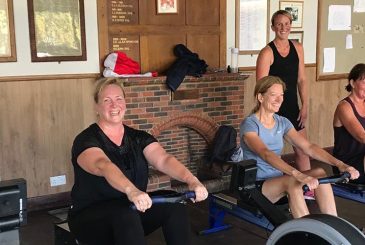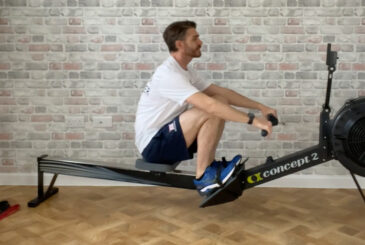Cross training can be described as engaging in two or more sports or types of exercise in order to improve fitness or performance in one’s main sport. It can be very beneficial during injury and rehabilitation, or even to add variety into your training.
I use cross training during the winter and early spring. Once we enter the racing season, I significantly reduce my cross training in order to maximise my in-boat focus. Here are four cross training activities that I enjoy doing.
Road cycling
Every season, both the GB men and women’s squads take part in a land-training camp, which involves a significant amount of road cycling. In November, the women head to the popular cycling island of Maorca and it’s popular for a reason. The roads are well maintained, providing an assortment of terrain and, most importantly, it is home to big climbs, the most infamous being Sa Calobra. A piece of road that will be forever etched in my mind, having pushed me to my mental and physical limits numerous times.
So why do we use road cycling as part of rowing training? Firstly, cycling is a great cardiovascular exercise that incorporates a lot of the same muscles that are essential to move a boat fast. Because your heart rate varies to a greater degree on the bike, compared to rowing, due to generally unavoidable changes in gradient, this offers up a new challenge and stress to the body.
A big benefit of road cycling is the length of time you can be on the bike. This can far exceed the time on the ergo or in the boat. The majority of our long steady-state rowing sessions last 90-100 minutes, so we are never pushing over the two-hour mark. However, you can ride the bike for over
six hours and this allows you to really push the endurance aspect of training.
Cycling tips
- Always wear a helmet! I seem to be a regular at kissing the tarmac (I blame it on my high centre of gravity) and each time, I have hit my head and cracked my helmet. Wearing a helmet is, in my eyes, a non-negotiable.
- Front and back lights on, even in daylight. This will make you considerably more visible to other road users.
- Wear gloves. When falling, your natural reaction is to put out your hands. If you end up with road rash on your hands, it will take a while until you can hold a handle.
- Drink plenty of fluid. Practise drinking while riding, a skill which will help you prevent dehydration.
Indoor cycling
If you find yourself injured or in rehabilitation, indoor cycling is particularly useful. Always seek advice from a qualified professional when injured, but cycling can be a good alternative to rowing if you need to take the load off your back or ribs. If you do find yourself off the rowing machine for a period of time, you need to trust that the bike is a great way to keep working on your endurance capacity.
Indoor cycling can also bring variety to your training. Variety is the spice of life after all!
The indoor bike can be challenging mentally. Having done a whole cycling camp on a turbo-trainer, I know this only too well! To pass the time, I listen to podcasts and music or watch a good film. Remember, time doesn’t stop and the session will come to an end eventually. Keep your mind on
the benefits of the session and the summer races you might be winning – if you train well.
With rowing being a leg-dominated sport, cycling on the road or indoors is the perfect cross training tool. It’s no coincidence that Olympic champion Rebecca Romero was so successful in switching from rowing to cycling.
Running
In the past, there has been some fairly unsubstantiated proposals that running leads to injury, particularly the idea that it is ‘bad for your knees’, especially as rowers tend to weigh considerably more than the likes of Mo Farah. However, the evidence suggests quite the opposite if you follow
some basic guidelines. I am a big fan. Through the winter, running is something I often enjoy on a Sunday morning. We spend the majority of our training sitting down, so I enjoy the odd occasion when I can be on my feet. Running is also a great tool to clear our often overactive minds.
Running tips:
- Invest in a good pair of running trainers that fit well. This will make it a lot more enjoyable and will help prevent injury.
- Build it up slowly. If you haven’t run in a while, even a short run of 20 minutes can lead to a lot of muscle soreness the next day.
Yoga
Why not incorporate yoga into your training routine? While it’s different from running or cycling, yoga will help you in other ways.
There are different types of yoga. Yang styles of yoga use rhythm and repetition, aiming to increase blood flow and build strength. Yin styles, such as restorative yoga, are about moving more slowly, and involve holding poses for longer and working on loosening muscles and joints. Both types teach you to breathe consciously and develop a greater understanding of your body.
I use yoga, especially restorative yoga, to unwind on a day off or after a training camp. I find it really relaxing, especially when it ends with a yogic sleep! I always sleep like a baby afterwards.
Savvy stretching
Rowing is a repetitive movement that puts significant load through the whole body, particularly the spine. Even when simply sitting, the pressure through our vertebral discs is 80% greater than while standing. This shows the importance of preparing our body before rowing. Part of this preparation is stretching.
My three favourite stretches are:
- Hip flexor – Our hip flexors work really hard in the rowing stroke and often get tight, so this is one of my go-to stretches.
- Angry cat/happy cat – On all fours, round and arch your back to loosen off your spine.
- Foam rolling – Think of foam rolling as self-massage. It increases blood flow, aids recovery and improves mobility.
Top 3 podcasts
- The Rich Roll podcast – Rich Roll is an incredible plant-powered ultra-endurance athlete, who has been on a transformational journey. He talks to inspiring guests from all walks of life. Check out his book, Finding Ultra, to be blown away by his story.
- Feel Better, Live More by Dr Chatterjee – Evidence-based advice on health and wellbeing from a doctor with great passion for improving the nation’s health.
- The Joe Rogan Experience – Hosted by a stand-up comedian and probably one of the most popular comedy podcasts, with a variety of guests.
–
–
–
–
–
–
–
–
–
–










